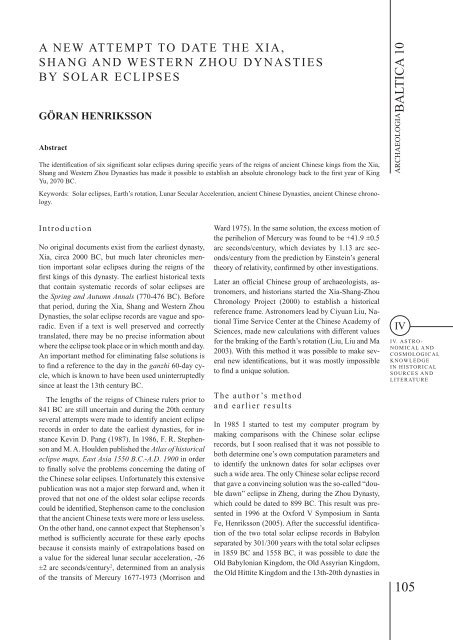BALTICA10
BALTICA10
BALTICA10
You also want an ePaper? Increase the reach of your titles
YUMPU automatically turns print PDFs into web optimized ePapers that Google loves.
A new attempt to date the Xia,<br />
Shang and Western Zhou Dynasties<br />
by solar eclipses<br />
GÖRAN HENRIKSSON<br />
Abstract<br />
The identification of six significant solar eclipses during specific years of the reigns of ancient Chinese kings from the Xia,<br />
Shang and Western Zhou Dynasties has made it possible to establish an absolute chronology back to the first year of King<br />
Yu, 2070 BC.<br />
Keywords: Solar eclipses, Earth’s rotation, Lunar Secular Acceleration, ancient Chinese Dynasties, ancient Chinese chronology.<br />
ARCHAEOLOGIA BALTICA 10<br />
Introduction<br />
No original documents exist from the earliest dynasty,<br />
Xia, circa 2000 BC, but much later chronicles mention<br />
important solar eclipses during the reigns of the<br />
first kings of this dynasty. The earliest historical texts<br />
that contain systematic records of solar eclipses are<br />
the Spring and Autumn Annals (770-476 BC). Before<br />
that period, during the Xia, Shang and Western Zhou<br />
Dynasties, the solar eclipse records are vague and sporadic.<br />
Even if a text is well preserved and correctly<br />
translated, there may be no precise information about<br />
where the eclipse took place or in which month and day.<br />
An important method for eliminating false solutions is<br />
to find a reference to the day in the ganzhi 60-day cycle,<br />
which is known to have been used uninterruptedly<br />
since at least the 13th century BC.<br />
The lengths of the reigns of Chinese rulers prior to<br />
841 BC are still uncertain and during the 20th century<br />
several attempts were made to identify ancient eclipse<br />
records in order to date the earliest dynasties, for instance<br />
Kevin D. Pang (1987). In 1986, F. R. Stephenson<br />
and M. A. Houlden published the Atlas of historical<br />
eclipse maps, East Asia 1550 B.C.-A.D. 1900 in order<br />
to finally solve the problems concerning the dating of<br />
the Chinese solar eclipses. Unfortunately this extensive<br />
publication was not a major step forward and, when it<br />
proved that not one of the oldest solar eclipse records<br />
could be identified, Stephenson came to the conclusion<br />
that the ancient Chinese texts were more or less useless.<br />
On the other hand, one cannot expect that Stephenson’s<br />
method is sufficiently accurate for these early epochs<br />
because it consists mainly of extrapolations based on<br />
a value for the sidereal lunar secular acceleration, -26<br />
±2 arc seconds/century 2 , determined from an analysis<br />
of the transits of Mercury 1677-1973 (Morrison and<br />
Ward 1975). In the same solution, the excess motion of<br />
the perihelion of Mercury was found to be +41.9 ±0.5<br />
arc seconds/century, which deviates by 1.13 arc seconds/century<br />
from the prediction by Einstein’s general<br />
theory of relativity, confirmed by other investigations.<br />
Later an official Chinese group of archaeologists, astronomers,<br />
and historians started the Xia-Shang-Zhou<br />
Chronology Project (2000) to establish a historical<br />
reference frame. Astronomers lead by Ciyuan Liu, National<br />
Time Service Center at the Chinese Academy of<br />
Sciences, made new calculations with different values<br />
for the braking of the Earth’s rotation (Liu, Liu and Ma<br />
2003). With this method it was possible to make several<br />
new identifications, but it was mostly impossible<br />
to find a unique solution.<br />
The author ’s method<br />
and earlier results<br />
In 1985 I started to test my computer program by<br />
making comparisons with the Chinese solar eclipse<br />
records, but I soon realised that it was not possible to<br />
both determine one’s own computation parameters and<br />
to identify the unknown dates for solar eclipses over<br />
such a wide area. The only Chinese solar eclipse record<br />
that gave a convincing solution was the so-called “double<br />
dawn” eclipse in Zheng, during the Zhou Dynasty,<br />
which could be dated to 899 BC. This result was presented<br />
in 1996 at the Oxford V Symposium in Santa<br />
Fe, Henriksson (2005). After the successful identification<br />
of the two total solar eclipse records in Babylon<br />
separated by 301/300 years with the total solar eclipses<br />
in 1859 BC and 1558 BC, it was possible to date the<br />
Old Babylonian Kingdom, the Old Assyrian Kingdom,<br />
the Old Hittite Kingdom and the 13th-20th dynasties in<br />
IV<br />
IV. ASTRO-<br />
NOMICAL AND<br />
COSMOLOGICAL<br />
KNOWLEDGE<br />
IN HISTORICAL<br />
SOURCES AND<br />
LITERATURE<br />
105
















